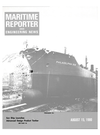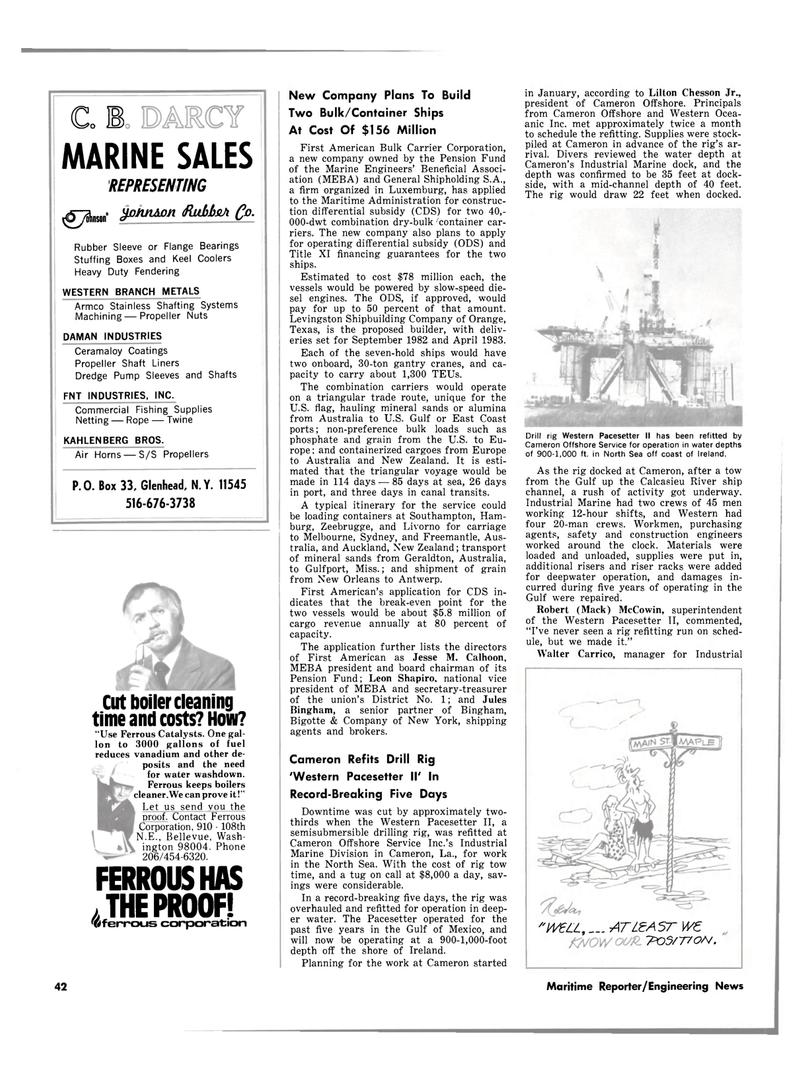
Page 40: of Maritime Reporter Magazine (August 15, 1980)
Read this page in Pdf, Flash or Html5 edition of August 15, 1980 Maritime Reporter Magazine
Co IB
MARINE SALES
REPRESENTING ^.nson (RllbbcA fa-
Rubber Sleeve or Flange Bearings
Stuffing Boxes and Keel Coolers
Heavy Duty Fendering
WESTERN BRANCH METALS
Armco Stainless Shafting Systems
Machining — Propeller Nuts
DAMAN INDUSTRIES
Ceramaloy Coatings
Propeller Shaft Liners
Dredge Pump Sleeves and Shafts
FNT INDUSTRIES. INC.
Commercial Fishing Supplies
Netting — Rope — Twine
KAHLENBERG BROS.
Air Horns — S/S Propellers
P.O. Box 33, Glenhead, N.Y. 11545 516-676-3738
Cut boiler cleaning time and costs? How? "Use Ferrous Catalysts. One gal- lon to 3000 gallons of fuel reduces vanadium and other de- posits and the need for water washdown.
Ferrous keeps boilers cleaner.We can prove it!"
Let us send you the proof. Contact Ferrous
Corporation, 910 - 108th
N.E., Bellevue, Wash- ington 98004. Phone 206/454-6320.
FERROUS HAS k THE PROOF! '©ferrous corporation
New Company Plans To Build
Two Bulk/Container Ships
At Cost Of $156 Million
First American Bulk Carrier Corporation, a new company owned by the Pension Fund of the Marine Engineers' Beneficial Associ- ation (MEBA) and General Shipholding S.A., a firm organized in Luxemburg, has applied to the Maritime Administration for construc- tion differential subsidy (CDS) for two 40,- 000-dwt combination dry-bulk/container car- riers. The new company also plans to apply for operating differential subsidy (ODS) and
Title XI financing guarantees for the two ships.
Estimated to cost $78 million each, the vessels would be powered by slow-speed die- sel engines. The ODS, if approved, would pay for up to 50 percent of that amount.
Levingston Shipbuilding Company of Orange,
Texas, is the proposed builder, with deliv- eries set for September 1982 and April 1983.
Each of the seven-hold ships would have two onboard, 30-ton gantry cranes, and ca- pacity to carry about 1,300 TEUs.
The combination carriers would operate on a triangular trade route, unique for the
U.S. flag, hauling mineral sands or alumina from Australia to U.S. Gulf or East Coast ports; non-preference bulk loads such as phosphate and grain from the U.S. to Eu- rope ; and containerized cargoes from Europe to Australia and New Zealand. It is esti- mated that the triangular voyage would be made in 114 days — 85 days at sea, 26 days in port, and three days in canal transits.
A typical itinerary for the service could be loading containers at Southampton, Ham- burg, Zeebrugge, and Livorno for carriage to Melbourne, Sydney, and Freemantle, Aus- tralia, and Auckland, New Zealand; transport of mineral sands from Geraldton, Australia, to Gulfport, Miss.; and shipment of grain from New Orleans to Antwerp.
First American's application for CDS in- dicates that the break-even point for the two vessels would be about $5.8 million of cargo revenue annually at 80 percent of capacity.
The application further lists the directors of First American as Jesse M. Calhoon,
MEBA president and board chairman of its
Pension Fund; Leon Shapiro, national vice president of MEBA and secretary-treasurer of the union's District No. 1; and Jules
Bingham, a senior partner of Bingham,
Bigotte & Company of New York, shipping agents and brokers.
Cameron Refits Drill Rig 'Western Pacesetter II' In
Record-Breaking Five Days
Downtime was cut by approximately two- thirds when the Western Pacesetter II, a semisubmersible drilling rig, was refitted at
Cameron Offshore Service Inc.'s Industrial
Marine Division in Cameron, La., for work in the North Sea. With the cost of rig tow time, and a tug on call at $8,000 a day, sav- ings were considerable.
In a record-breaking five days, the rig was overhauled and refitted for operation in deep- er water. The Pacesetter operated for the past five years in the Gulf of Mexico, and will now be operating at a 900-1,000-foot depth off the shore of Ireland.
Planning for the work at Cameron started in January, according to Lilton Chesson Jr., president of Cameron Offshore. Principals from Cameron Offshore and Western Ocea- anic Inc. met approximately twice a month to schedule the refitting. Supplies were stock- piled at Cameron in advance of the rig's ar- rival. Divers reviewed the water depth at
Cameron's Industrial Marine dock, and the depth was confirmed to be 35 feet at dock- side, with a mid-channel depth of 40 feet.
The rig would draw 22 feet when docked.
Drill rig Western Pacesetter II has been refitted by
Cameron Offshore Service for operation in water depths of 900-1,000 ft. in North Sea off coast of Ireland.
As the rig docked at Cameron, after a tow from the Gulf up the Calcasieu River ship channel, a rush of activity got underway.
Industrial Marine had two crews of 45 men working 12-hour shifts, and Western had four 20-man crews. Workmen, purchasing agents, safety and construction engineers worked around the clock. Materials were loaded and unloaded, supplies were put in, additional risers and riser racks were added for deepwater operation, and damages in- curred during five years of operating in the
Gulf were repaired.
Robert (Mack) McCowin, superintendent of the Western Pacesetter II, commented, "I've never seen a rig refitting run on sched- ule, but we made it."
Walter Carrico, manager for Industrial '•WZZ, AT LEAST W£
TQ5/T/ON. 42 ZIDELL Maritime Reporter/Engineering News

 39
39

 41
41
